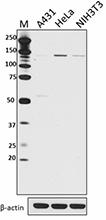- Clone
- 1B2-2A8 (See other available formats)
- Regulatory Status
- RUO
- Other Names
- Hamartin, Tuberous sclerosis 1 protein, KIAA0243, TSC, TSC 1
- Isotype
- Mouse IgG1, κ
- Ave. Rating
- Submit a Review
- Product Citations
- publications

-

Total cell lysates (15 µg protein) from A431, HeLa and NIH3T3 were resolved by 4-12% Bis-Tris gel electrophoresis, transferred to nitrocellulose, and probed with 2 µg/mL purified anti-Hamartin (TSC1) (clone 1B2-2A8) antibody (upper). Proteins were visualized using a goat anti-mouse-IgG secondary antibody conjugated to HRP and chemiluminescence detection. Direct-Blot™ HRP anti-β-actin antibody was used as a loading control (lower). Lane M is the molecular weight ladder.
| Cat # | Size | Price | Quantity Check Availability | Save | ||
|---|---|---|---|---|---|---|
| 696502 | 100 µg | 221€ | ||||
Tuberous sclerosis complex (TSC) is an autosomal dominant disorder that is due to inactivating mutations in TSC1 (also known as hamartin) or TSC2 (also known as tuberin). TSC is featured by benign tumors (hamartomas) involving multiple organ systems. TSC1, TSC2 and TBC1 domain family member 7 (TBC1D7) form the TSC protein complex that acts as an inhibitor of the mechanistic target of rapamycin (mTOR) signaling, which in turn plays a critical role in regulating cell growth, proliferation, autophagy and protein and lipid synthesis. The TSC protein complex controls the activity of mTORC1 via RAS homologue enriched in brain (RHEB). mTORC1 downstream targets include phospho‑p70 ribosomal S6 kinase, phospho-ribosomal protein S6 and phospho‑4EBP1 (eukaryotic translation initiation factor 4E‑binding protein 1). Activation of mTORC1 enhances protein translation, and hyperactivation of mTORC1 has been discovered to lead to extensive metabolic reprogramming, including effects on glycolysis, autophagy, nucleotide biosynthesis and lipid biosynthesis. In many cases, this reprogramming leads to vulnerabilities that induce cell death indicating that the altered metabolism of cells with mTORC1 hyperactivation will provide therapeutic opportunities. By contrast, inhibition of mTORC1 with allosteric inhibitors, such as sirolimus and everolimus, restores TSC2‑deficient cells to metabolic homeostasis and may thereby ‘protect’ them from cell death.
In addition to the canonical TSC–RHEB–mTORC1 pathway, there is evidence of non-canonical pathways. These include targets of TSC1 that are TSC2 independent, targets of TSC1 and TSC2 that are RHEB independent and targets of RHEB that are mTORC1 independent.
Product Details
- Verified Reactivity
- Human, Mouse
- Antibody Type
- Monoclonal
- Host Species
- Mouse
- Immunogen
- Partial human TSC1 recombinant protein (480-666 a.a.)
- Formulation
- Phosphate-buffered solution, pH 7.2, containing 0.09% sodium azide.
- Preparation
- The antibody was purified by affinity chromatography.
- Concentration
- 0.5 mg/ml
- Storage & Handling
- The antibody solution should be stored undiluted between 2°C and 8°C.
- Application
-
WB - Quality tested
- Recommended Usage
-
Each lot of this antibody is quality control tested by Western blotting. For Western blotting, the suggested use of this reagent is 0.5 - 5.0 µg per ml. It is recommended that the reagent be titrated for optimal performance for each application.
- Application Notes
-
As per the Human Protein Atlas RNA level dataset, A431 is expected to have a low level of TSC1 expression.
This clone weakly cross-reacts with mouse.
Clone 1B2-2A8 does not work for IF (in-house tested).
- RRID
-
AB_2687066 (BioLegend Cat. No. 696502)
Antigen Details
- Structure
- 1164 amino acids with a predicted molecular weight of 130 kD.
- Distribution
-
Cytoplasm, Membrane
- Function
- In complex with TSC2, inhibits the nutrient-mediated or growth factor-stimulated phosphorylation of S6K1 and EIF4EBP1 by negatively regulating mTORC1 signaling.
- Interaction
- Interacts with TSC2, DOCK7, FBXW5 and TBC1D7.
- Biology Area
- Apoptosis/Tumor Suppressors/Cell Death, Cell Biology, Signal Transduction
- Antigen References
-
1. Henske EP, et al. 2016. Nat. Rev. Dis. Primers. 2: 16035.
2. Kwiatkowski DJ and Manning BD. 2014. N. Engl. J. Med. 371: 778.
3. Dibble CC and Cantley LC. 2015, Trends Cell Biol. 25:545.
4. Neuman NA and Henske EP. 2011. EMBO Mol. Med. 3:189.
5. Han JM and Sahin M. 2011. FEBS Lett. 585:973. - Gene ID
- 7248 View all products for this Gene ID
- UniProt
- View information about Hamartin on UniProt.org
Related Pages & Pathways
Pages
Related FAQs
Other Formats
View All Hamartin (TSC1) Reagents Request Custom Conjugation| Description | Clone | Applications |
|---|---|---|
| Purified anti-Hamartin (TSC1) | 1B2-2A8 | WB |
Compare Data Across All Formats
This data display is provided for general comparisons between formats.
Your actual data may vary due to variations in samples, target cells, instruments and their settings, staining conditions, and other factors.
If you need assistance with selecting the best format contact our expert technical support team.
-
Purified anti-Hamartin (TSC1)

Total cell lysates (15 µg protein) from A431, HeLa and NIH3T...
 Login / Register
Login / Register 







Follow Us